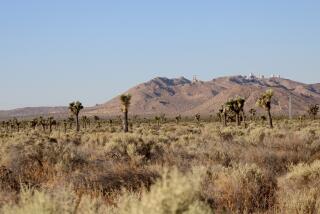SOUTHERN CALIFORNIA’S ENVIRONMENT At the Crossroads : ENERGY: ASSESSING ITS ROLE : Future Wave Now Makes Just a Ripple
- Share via
Five thousand feet below the Mojave Desert, where molten rock comes near underground reservoirs of water, a head of natural steam holds the possibility of reshaping Southern California’s energy future.
The natural caldron is being tapped to power a network of geothermal power plants that produce enough electricity to light 200,000 homes.
Not far away, gleaming six-foot solar mirrors stretch for miles across the desert floor near Barstow to heat synthetic oil, which continuously circulates through a loop of pipes to a scorching 735 degrees Fahrenheit.
Part of the loop is emersed in water, bringing it to a boil to make steam to run electric turbines that produce enough power for 270,000 people.
“What’s coming out of the plant is the cleanest electrons in the world,” said David McClain, manger of the California Energy Co.’s geothermal plant. Similar enthusiasm is voiced by Luz International of Los Angeles, which built the solar thermal plant near Barstow, the world’s largest.
Many see the two plants as the wave of the future, although at the moment they are more of a ripple. Geothermal plants produce 5.7% of the state’s electricity needs and solar far less, just 0.2%.
And the role that geothermal- and solar-generated electricity will play in the future depends on a number of economic factors.
Tax credits and laws that gave solar and geothermal electricity a boost are winding down. Now, independent energy entrepreneurs are pushing for extensions and new regulatory approaches that take environmental factors like air pollution into account in figuring energy costs. They say that will make them more competitive with electricity generated by conventional technologies like coal or gas-fired power plants.
More to Read
Inside the business of entertainment
The Wide Shot brings you news, analysis and insights on everything from streaming wars to production — and what it all means for the future.
You may occasionally receive promotional content from the Los Angeles Times.










